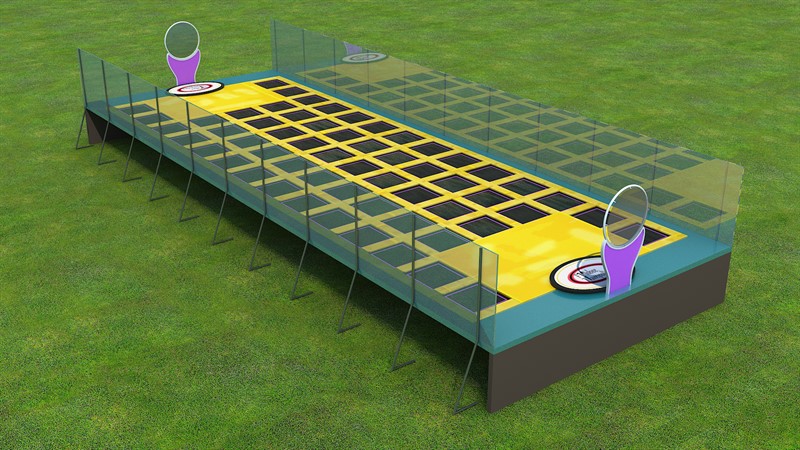The new sport of Frisbee Trampoline was created by Yoav Lerner from Israel in 2016. Frisbee Trampoline is a non-contact team sport played with a flying disc on a playing field of 60 trampolines.
Equipment Required:
- A playing field of trampolines. At each end of the playing field there is a goal. The goal is located 8 feet high and it's a 5 feet diameter, vertical positioned, metal ring with a net behind it.
- A Frisbee
THE AIM OF THE GAME: Frisbee Trampoline is a non-contact team sport played with a flying disc. Two teams of five players and one goalie compete on a playing field of 60 trampolines. At each end of the playing field there is a goal. The goal is located 8 feet high and it's a 5 feet diameter, vertical positioned, metal ring with a net behind it. In front of each goal there is a big trampoline (bigger than the rest of the trampolines on the field). This trampoline uses the goalie and the goalie only in order to defend the goal.
Description
- The game is being played during four quarters of 10 minuets net time each like in basketball. After each quarter the teams switch sides.
- The goalie starts the attack by passing the Frisbee to one of his team mates.
- Players can throw (pass to a team mate or shoot a goal) and catch the Frisbee only while being in the air (not touching the ground)
- Once a player catches the Frisbee in the air they must keep on jumping (not standing, not running)
- After 3 jumps with the Frisbee in their hands (on the same trampoline or from one trampoline to another), players must pass over the Frisbee to a team mate or shoot a goal.
- If a player of the attacking team is breaking one of the rules or the Frisbee falls down on the ground than the other team will get the Frisbee on this same point and start a new attack immediately without stopping the game
- The defense team must avoid any physical contact with the players of the attacking team in the general and with the payer who is holding the Frisbee in specific - they are not aloud to jump into a trampoline that another player is jumping on.
- Any physical contact that will be caused by the defense team will be considered a Foul which will stop the game and give the attacking team a free shoot of the Frisbee from a 20 feet distance from the goal (not free of goalie)
- The defense team should try to throw down the Frisbee or catch it in the air and than start a new attack.
- Of course that the team that score more goals wins (:
Right now there is not an official standard court of Frisbee Trampoline (like in the image) but until one is being built (hopefully soon) it can be played in one of the thousands of Trampoline parks around the world with small adjustments.
Rate this Sport
What do you think about this 'sport'? Please rate it on its potential.
Note
Related Pages
- Other New Sports
- Another new sport: Frisbee Ball — try and get the ball into the score zone while bouncing it on a frisbee.
- Frisbee (Disc) Sports
- Complete list of unusual sports
Disclaimer


 Frisbee Trampoline Field
Frisbee Trampoline Field Current Events
Current Events